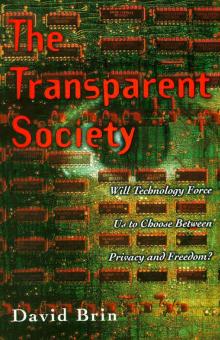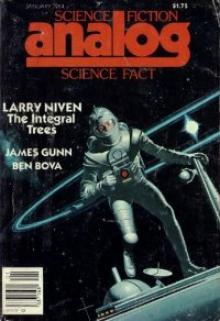- Home
- David Brin
Chasing Shadows: Visions of Our Coming Transparent World
Chasing Shadows: Visions of Our Coming Transparent World Read online
Begin Reading
Table of Contents
About the Authors
Copyright Page
Thank you for buying this
Tom Doherty Associates ebook.
To receive special offers, bonus content,
and info on new releases and other great reads,
sign up for our newsletters.
Or visit us online at
us.macmillan.com/newslettersignup
For email updates on David Brin, click here.
For email updates on Stephen W. Potts, click here.
The author and publisher have provided this e-book to you without Digital Rights Management software (DRM) applied so that you can enjoy reading it on your personal devices. This e-book is for your personal use only. You may not print or post this e-book, or make this e-book publicly available in any way. You may not copy, reproduce, or upload this e-book, other than to read it on one of your personal devices.
Copyright infringement is against the law. If you believe the copy of this e-book you are reading infringes on the author’s copyright, please notify the publisher at: us.macmillanusa.com/piracy.
To Nellie Bly, who showed us how it’s done
—David Brin
To Brian, my scion, who believes in the future
—Stephen W. Potts
And from both of us …
… for David G. Hartwell, who made this book happen and who did more than anyone else to keep our brave literature of exploration and the mind aimed forward into the future.
How we’ll miss you.
Tsunami of lights
Life is illuminated
Scrutinize the eyes
INTRODUCTION
PRIVATE LIVES
JAMES GUNN
We look upon the current debate between privacy and the various forms of technology-driven surveillance as a contemporary issue, but it seems to be central to the human condition.
Among our hunter/gatherer ancestors privacy must have been a rare commodity, if it was possible at all. In a small group dependent upon every member for mutual survival, secrets are not only hard to protect, they may be dangerous. Once agriculture was introduced and life became more stable, predictable, and attached to a particular place, the issue of privacy—surely a central condition of self-consciousness and the growing possibilities of individualism—could take root along with the grains humans were beginning to plant.
Commerce and the development of early technologies led to larger communities and then to cities, where rural families, attracted to new opportunities, would migrate, leaving behind their social ties and intimacies for the anonymity of urban life. As a personal example, my wife grew up in a rural town of two thousand (which she always remembered as a golden time), and I was astonished by the familiarity she displayed, without considering it unusual, with the details of everybody’s life and situation. I, on the other hand, grew up in a city where I knew only the people who lived on the same block, and even then only a few and nothing at all about those who lived across the street. My mother knew more and sometimes enlightened me, so my lack of social knowledge may have been the tunnel vision of youth, but even later, in neighborhoods where my own family was established, personal information was sheltered, and bits of insight came as revelations.
A consequence of urban anonymity was the attempt to replace common small-community intimacy with substitutes that could at least provide the illusion of familiarity: gossip, informal and formal groupings like clubs and organizations, and media, beginning with town criers and progressing to newspapers, radio, television, and finally the return to the self-revelations of today’s social media. To be sure, each of these had other purposes—clubs and organizations got people of similar interests together to further social goals, while news-gathering-and-dispensing innovations had public information functions—but they also served the basic human need for connection and even the desire for insights into everyone else’s personal histories. How else can we explain the enduring popularity of interviews, feature stories, agony columns, talk shows, and confessionals? Even, perhaps, the autobiography?
So, it seems to me, these two human attributes—the protection from public scrutiny of our inner selves and even of our personal activities that we call privacy, and the desire for intimate knowledge of others and the impulse toward self-revelation that is subsumed under surveillance—have been in conflict from the beginning. It is only in current circumstances, with the society-wide availability of electronic communication devices, that the conflict has come to a head.
WE SAW IT COMING
Science fiction isn’t a predictive medium. It is a speculative genre, invested in creating plausible scenarios extrapolated from current developments. John W. Campbell once wrote that it exists between the laboratory and the marketplace, between possibility and availability. But every now and then—like a stopped clock that is right twice a day—perceptive authors come up with scenarios that match future realities. Surveillance was one of them. Shortly after the Second World War, George Orwell began work on his magnum opus, 1984, which would terrify tens of millions into a lifelong dread of one-way, top-down, universal observation, the most potent tool of any would-be Big Brother.
Orwell wasn’t alone. Others were already pondering the notion of transparency—a world not of surveillance, but omniveillance. For example, Pulitzer Prize–winning author John Cheever’s “The Enormous Radio”—published in the May 17, 1947 issue of The New Yorker—takes place in the New York apartment of Cheever’s favorite characters, Jim and Irene Westcott, only this time the Westcotts enter a sci-fi warp. (The story would be adapted for The Twilight Zone.) As described by critic David Truesdale:
Irene is distraught when their radio quits. Jim buys an expensive new one, which they soon discover has some … unusual qualities. This radio picks up the most unusual conversations from their neighbors, and shows that beneath the surface displayed to the public, people argue and fight, showing their true selves and lesser natures behind closed doors. It becomes such a distraction and troubles Irene to the point of depression that she convinces Jim to get rid of the damned machine. Whereupon, several strange twists occur in their own relationship.
Several stories in Chasing Shadows take on this theme, portraying potential effects of transparency on relationships—isn’t it said that the truth can cleanse, but it can also hurt?
Continuing our scan of classic, transparency-related science fiction, T. L. Sherred’s “E for Effort” showed that a device for filming the past could also spy on everyone’s secrets, anticipating dozens of paranoia-inducing films. Not many years after Orwell and Cheever, in a 1962 issue of Analog, “The Circuit Riders” by R. C. Fitzpatrick envisioned a future when a kind of radar can detect individual emotions at long range—at least those that involve anger, verging on violence. Police use triangulation to zero in and detain potential murderers, in a manner not too dissimilar to Philip K. Dick’s later “Minority Report” (still later filmed by Steven Spielberg). Fitzpatrick forgoes the absurd exaggerations of Dick and Spielberg, making clear that such detentions can only be precautionary and nonpunitive—a matter of brief triage and observation and warning—and hence the state’s use of this method is portrayed as benign. Though the reader can extrapolate in either direction. Might this paternalistic power coalesce into something Orwellian, if it stays a state monopoly?
Or else, suppose that everyone gets access to such emotional radar? That is the notion explored by several stories in this volume.
An Internet search for “surveillance in science fict
ion” turned up a long list featuring “aerostat monitors” (Neal Stephenson) to “zed-rays” (Ray Cummings in 1936) and including “Invisible Watchers” (Edmond Hamilton, 1938), “Watchbird” (Robert Sheckley) and “Surveillance” (John Brunner, 1975). One of the earliest, surely, was Russia’s Yevgeny Zamiatin’s We. Two of the most recent are David Brin’s Earth and Cory Doctorow’s Little Brother, although the last was more reactions to present realities than anticipation.
One of my favorites is “Private Eye” by “Lewis Padgett” (the writing team of Henry Kuttner and C. L. Moore) in their 1949 speculation in Analog, 1949, which offered the ultimate surveillance system in the ability to recover images from the imprint of light rays on everyday walls. In the story it is used as a crime-fighting device and a way to prove intent, but it is a remarkable anticipation of the kind of universal surveillance that street, shop and home cameras aim at and toward which, perhaps, the trend is heading. Moreover, it offers an aspect to technological developments that I will return to later—the ability of people to adjust their behavior to accommodate new conditions. In “Private Eye,” it is the ability of a single clever criminal to conceal intent (the story is more concerned with psychological issues than privacy invasions) just as, in William Gibson’s Neuromancer, the lower levels of society develop their own methods (“street smarts”) for surviving, and even eventually prevailing over, seemingly overwhelming technological difficulties—thus earning the “punk” part of “cyberpunk.”
Oh, but even such meticulous care will be for naught, if we get the ultimate-transparency future portrayed by Damon Knight in his classic 1972 story “I See You” (included in this volume). When neither law, nor technology nor cleverness can prevent everyone from seeing absolutely everything, human adaptability might mean changing every assumption that our ancestors held. This possibility is also explored thirty years later by Arthur C. Clarke and Stephen Baxter in their novel The Light of Other Days, wherein a “WormCam” allows anyone to observe anything through tiny wormholes, even using the technology to link minds.
Again and again, the real question is not whether new technologies will keep expanding humans’ ability to see. The core dilemma is who will get these powers? Even if they are widely shared—thus preventing Big Brother—will that lead to wise citizenship? Or the opposite?
* * *
It is this bold tradition of thought-experimentation that Chasing Shadows carries forward, exploring possible consequences of what David Brin has called a “tsunami of light.” Some authors react to this onrush of new sensory power with dread or loathing, as in Scott Sigler’s “Public Domain,” Jack McDevitt’s “Your Lying Eyes,” or Robert Silverberg’s classic “To See the Invisible Man” (included in this volume), which contrasts in interesting ways to David Brin’s story “Insistence of Vision.”
Others take up the point made in Brin’s The Transparent Society, that freedom and safety and even compassion may augment, if we all share the ability to look back, especially at power—a theme struck in this volume by James Morrow, Nancy Fulda, Brenda Cooper and Vylar Kaftan. Meanwhile, affecting stories by David Ramirez and Cat Rambo stand on a middle ground—aware of benefits, while noting too a poignant sense of passage.
TECHNOLOGY’S DANCE WITH SCIENCE FICTION
Do these stories reveal where we’re all heading? The recent development of the smartphone comes at the end of a long line of communication devices intended to lessen the distance—or even the isolation—of people separated by other technological improvements such as roads, railroads, ships and other forms of getting people from one place to another in accessible and affordable ways. First came the handwritten message, the daily mail, the telegraph and eventually the telephone. The fact that these were instruments of basic human intercourse was underscored by a numbered series of standard messages used by families of service personnel during World War II to save the wires for official use. One such message was “I am pregnant,” which led one congressman to suggest that a companion message ought to be “I am not pregnant.”
The development of the telephone fostered a culture of self-revelation. What was difficult to say face-to-face became easier to talk about into a receiver in the sanctity of one’s own home. But it also meant that strangers could intrude into your own private space, and even friends and family members might be induced by this deceptive new device to blurt out unwelcome “truths.” In the film Inherit the Wind, Spencer Tracy as defense lawyer Clarence Darrow sums up to the jury the way in which technology changes the world, “Sure you can have the telephone—but you’ll give up your privacy.” Protocols for using such technologies were immediately adopted and then evolved.
So it was with the computer. When I got my first computer, probably about 1980, it was only a machine for creating documents, an upgrade from the electric typewriter, which was itself an upgrade from the standard typewriter, which was itself an upgrade over the portable Smith-Corona with which I started my literary life. My first computer printer was really just a glorified electric typewriter. But then the computer was connected to the Internet, and it became a device that allowed me to communicate with people anywhere, particularly in distant places. And the messages that once took days or even weeks to reach foreign friends and potential students and colleagues now were virtually instantaneous.
I speculated then that the generation that grew up with the world at their fingertips would experience a different concept of distance. People in far-off places would no longer be aliens; they would be as close as the people you see every day. Surely, I thought, violent conflicts between people of different races and different political beliefs would no longer be possible when potential enemies could no longer be dehumanized. I’m not sure it has worked out that way. Maybe the older generation, with all of its misconceptions, is still in charge. Or maybe the younger generation still has time to shape a new world.
Certainly the smartphone, with its unrelenting communication, its textual temptations, and its ability to photograph or film anything, any time, any where, has raised the stakes. The concept of the world as a place you can reach out to if you wish is now something that you carry around with you. In fact, for many, it is something they cannot do without. I see students on campus every day walking to their classes with phones held to their ears, oblivious to the scenery or their fellow students or even the traffic, which halts obligingly for them to cross. Not every place is so forgiving. Many years ago I wrote a story about the development of a silencer that shut out noise by broadcasting a wave 180 degrees out of phase. One side effect was that people got struck down by cars they didn’t hear. Horace Gold thought it was ridiculous that people would abandon the habits of a lifetime and rejected it. But that’s what has happened to the phone-addicted generation—and it will get both worse and better, as they start to wear augmented reality glasses that overlay artificiality upon the real world, complete with noise-canceling earbuds and overlays that cover up whatever they do not wish to see.
Protocols have developed for smartphones as well, though they are still in flux. It turns out that people using smartphones while driving, particularly texting, are distracted. They have accidents and kill other people and themselves. So first we have campaigns urging people to stop, and then we get laws. Eventually, people learn how to live with it rather than die by it. But they’ll get the right to text at the wheel back soon, when cars are driving themselves. Meanwhile, those selfsame phones will tap into satellite views of traffic, just ahead, or whether your luncheon date is still waiting for you, by the public fountain. And yes, this too will call on us to adapt.
That brings me to my final point. With every new technological development, there are a series of reactions that vary from individual to individual and from group to group, ranging from joyous acceptance to disdainful rejection. But if the new technology has benefits, if it makes life—for a sufficient number—more efficient or more interesting, it gets adopted and its use becomes broadspread enough to change the nature of soci
ety itself.
The rise of social media may not have been as predictable. The ways in which people can interact—orally, textually, and visually—proliferate, and it is difficult to see at this point in the evolution of digital devices and methods of aggregating communications where the advancements will end. Perhaps never as long as there is money—or, at least, the prospect of profits—to be made from providing platforms and as long as there is a hunger, particularly among the young, for intimate interactions at a distance.
All of this has coincided with, or been precipitated by, a growing fascination among the young for self-revelation and a consequent contraction of the need for, or perhaps even the expectation of, privacy. Combine this with the possible anonymity of the Internet and growing political uprisings across the world and the potential for social revolution is high and rising. Protocols for resolving such conflicts are still debated. On one side are the forces of tradition and government, both of which want to set limits and monitor transgressions; on the other, the dynamism of technologies, voiced by spokespeople within science fiction such as Cory Doctorow and preempted by political revolutionary groups like ISIS. Where it will all come out is still, at this time, in doubt.
One outcome is certain, however: technologies will win. The genie is out of the bottle. Hardly ever in the history of invention (with the possible exception, so far, of the thermonuclear bomb) has a powerful technology been invented and not implemented. It is useful to remind ourselves, however, of Isaac Asimov’s musings about “futuristics,” which ended with his comment that it isn’t the prediction that is difficult but the side effect, the unanticipated consequence: not the automobile, he wrote, but the traffic jam; not radio but the soap opera; not the income tax but the expense account.
And a comment that Horace Gold once wrote to me when he was laying out instructions about writing stories for Galaxy: “The truest thing that humanity has learned is that you can’t fight city hall.” So it is with whatever state of affairs science, technology and politics may bring about. Humanity will learn how to live with it. We will learn how to balance our desire for interaction and intimacy against our need to preserve our inner selves against exposure.

 The Practice Effect
The Practice Effect Infinity's Shore
Infinity's Shore Insistence of Vision
Insistence of Vision Sundiver
Sundiver Brightness Reef
Brightness Reef Existence
Existence The Transparent Society
The Transparent Society Startide Rising
Startide Rising The Postman
The Postman The Uplift War
The Uplift War The Loom of Thessaly
The Loom of Thessaly Otherness
Otherness Sundiver u-1
Sundiver u-1 The Uplift War u-3
The Uplift War u-3 Infinity's Shore u-5
Infinity's Shore u-5 Brightness Reef u-4
Brightness Reef u-4 Uplift 2 - Startide Rising
Uplift 2 - Startide Rising Kiln People
Kiln People Heaven's Reach u-6
Heaven's Reach u-6 The Transparent Society: Will Technology Force Us to Choose Between Privacy and Freedom?
The Transparent Society: Will Technology Force Us to Choose Between Privacy and Freedom? Star Wars on Trial
Star Wars on Trial Lungfish
Lungfish Tank Farm Dynamo
Tank Farm Dynamo Just a Hint
Just a Hint A Stage of Memory
A Stage of Memory Foundation’s Triumph sf-3
Foundation’s Triumph sf-3 Thor Meets Captain America
Thor Meets Captain America Senses Three and Six
Senses Three and Six The River of Time
The River of Time Chasing Shadows: Visions of Our Coming Transparent World
Chasing Shadows: Visions of Our Coming Transparent World Foundation's Triumph
Foundation's Triumph Startide Rising u-2
Startide Rising u-2 The Fourth Vocation of George Gustaf
The Fourth Vocation of George Gustaf The Heart of the Comet
The Heart of the Comet The Crystal Spheres
The Crystal Spheres